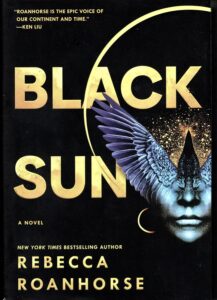Book review: Black Sun
Rebecca Roanhorse’s latest literary work, Black Sun, shifts from monster hunters of the southwest to a fantasy novel based loosely on various cultures of the pre-Columbian Americas. Black Sun is the first published book of the Between Earth and Sky trilogy.
The setting is a fictional region known as the Meridian where Tova is the dominate city. The city is divided into six districts – Tsay (Golden Eagle Clan), Titidi (Water Strider Clan), Kun (Winged Serpent Clan), Odo (Carrion Crow), the Maw (a clanless district), and Otsa (home to the Watchers). The city itself as well as all of Meridian are ruled by the Watchers, who are a priestly class supported by the four clans. Together, the Watchers and the Clans dominate the cities and towns of Cuecola, Huecha, and Tovasheh, who the story hints are chafing at Tovan rule.
The three main characters are Xiala, Serapio, and Naranpa. Xiala is a female ship’s captain who hails from a mysterious people known as the Teek, whom the Tovans do not control. As a Teek, the mainlanders or dry earth people see her as mystical whether alive or dead. She is tasked with bringing Serapio, a member of the Crow clan and potential god, to the city of Tova in time for the Convergence celebrations. Serapio appears as a man of mystery whose story gradually unfolds as the climax approaches. Naranpa, the Sun Priest, hails from the Maw district of Tova. The Maw is the seedy underworld of Tova, where Denaochi, the brother of Naranpa, is a key ‘mobster’ and where various citizens of Tova go to indulge in a variety of vices. Naranpa managed to ascend to the heights of the Tovan religious hierarchy by becoming the Sun Priest. She faces opposition from within the priestly order and ruling clans of Tova as she attempts to re-establish respect for the Watchers and bridge the gulf with the Crow.
The key conflict within the plot is the desire of the Crow to avenge a massacre of its people decades earlier. This massacre of the Crow was done by the Watchers under the orders of a long-dead Sun Priest. Xiala’s, Serapio’s, and Naranpa’s stories end with beginnings as the solar eclipse, known as the Convergence, hangs motionless in the sky. This sets the stage for further conflict, drama, and resolution in the second and third volumes.
Black Sun is an interesting read. It starts incredibly slowly as Roanhorse, almost painstakingly, traces the three key characters’ backstories, develops tertiary characters (many of whom die at various points), as well as explains ongoing political and religious intrigues. Inspired by Mayan, Aztec, Polynesian, and Tewa cultures and histories, among others, Roanhorse takes her time developing a feel for the different peoples, customs, cities, and civilizations within the Meridian. This allows for the creation of a vibrant immersive fantasy world. There are a few sections of the book where Roanhorse’s use of pronouns across two or three characters becomes confusing, requiring a quick flipping back and forth to remind the reader of whom or who is talking, being talked about, or merely present in the scene. The climax, known as the Convergence, occurs far too quickly in the novel, becoming a fast-paced series of events that appear out of step with the earlier plodding character, plot, and setting development. Nonetheless, the book overall is an enjoyable and interesting read that will appeal to fantasy fans as well as those seeking a different kind of story by an Indigenous author. I am looking forward to the release of Fevered Star, the second volume of the trilogy in 2022.
Rebecca Roanhorse. Black Sun. Toronto: Saga Press, 2020.
ISBN: 9781534437678



